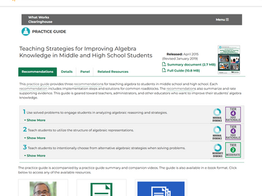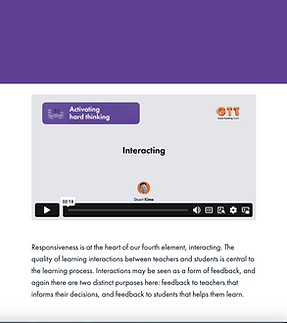Overview

A worked example demonstrates the steps required to complete a task or solve a problem.By scaffolding the learning, worked examples support skill acquisition and reduce a learner’s cognitive load. The teacher presents a worked example and explains each step. Later, students can use worked examples during independent practice, and to review and embed new knowledge.
Key Elements
-
Teacher clarifies the learning objective, then demonstrates what students need to do to acquire new knowledge and master new skills
-
Teacher presents steps required to arrive at the solution so students’ cognitive load is reduced and they can focus on the process
-
Students practice independently using the worked example as a model

Related Effect Sizes
-
Worked examples – 0.57
-
Spaced practice – 0.60
This strategy is demonstrated when the teacher:
Scaffolds the acquisition of new knowledge and skills by presenting students with a clear, step-by-step example
Designs worked examples that are accessible to students (self-explanatory) and unpacks the learning process, highlighting options available to arrive at the correct solution
Monitors student learning and supports students to move towards more independent practice.
This strategy is NOT demonstrated when the teacher:
introduces new knowledge and skills with worked examples that are too complex and inaccessible to learners
Uses the same worked examples for all learners, including those with an already advanced knowledge of the topic or subject matter.
This strategy is demonstrated when students:
are engaged and on task because the worked example is pitched at the right level of challenge
Understand that the focus is on understanding the process required to complete the task
Can move with confidence from using worked examples to independent practice.
Typical problems of practice in this area:
Examples are too different from the task and students have not been taught the skills needed to translate what is demonstrated in the worked example to their own task
Examples are too similar to the task and students are not practicing the skill that is being taught and is instead relying on other skills to achieve the task (e.g. changing only a few words, basically copying the example)
Students are overwhelmed by the volume of instructions and material needed to be processed before even starting the task
The examples are not the "right" level for the student (too difficult - student feels the task is unachievable; too easy - student is unsure of what the next step should look like)
Time to go over the examples and teach how to use the examples with students in class
Students are not sure what ideas they are supposed to gain from the example
Possible LfL questions to ask students
SS: What strategies do you use to solve problems in this course?
MS: Do you feel that using "worked examples" in class has helped improve your ability to answer questions? If so, how? If not, what could make them more helpful? An example of a "worked example" would be the GUESS framework or Claim, Evidence, Justification
JS/MS: which of the following worked examples did you find useful? (check all that apply) - list worked examples presented in class.
JS: Before starting a new task, how do your teachers show you examples of what it should look like?
-
Learners experience supportive, respectful, and authentic relationships
-
Learners thrive in an environment that is both safe and challenging
-
Learners understand the purpose of their learning
-
Learners readily connect new learning with previous knowledge, concepts and skills
-
Learners feel individually challenged at an appropriate level
-
Learners have increasing agency in their learning
-
Learners receive ongoing feedback
-
Learners experience a range of learning and teaching methodologies
-
Learners have ample opportunities to practise
-
Learners have regular opportunities to collaborate with and learn from others
Reminder of the TLPP

Training Materials from GTT (Great Teaching Toolkit)
How the Great Teaching Toolkit supports this HIT
Element 4.4 Interacting (See article “Desirable difficulties”)
Element 4.5 Embedding

















